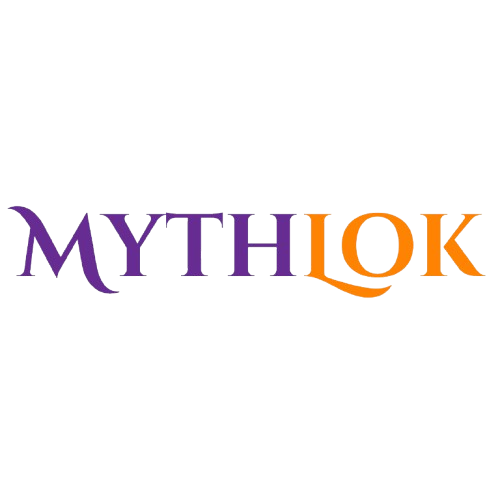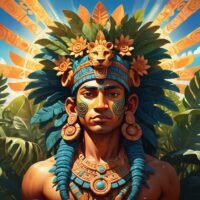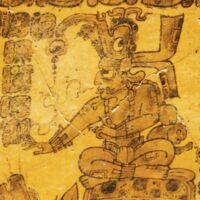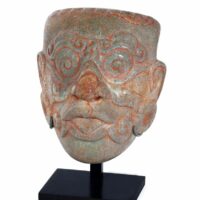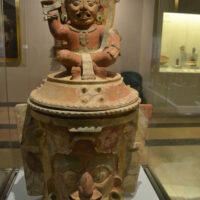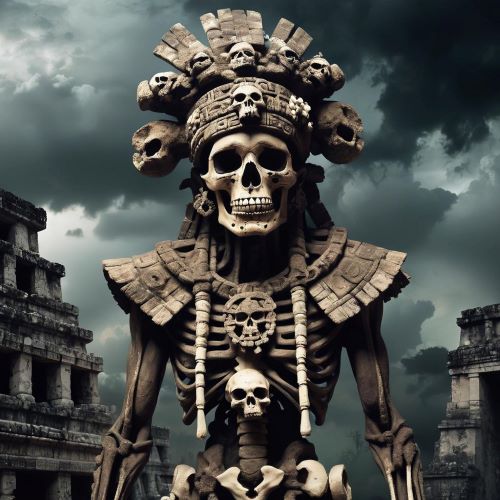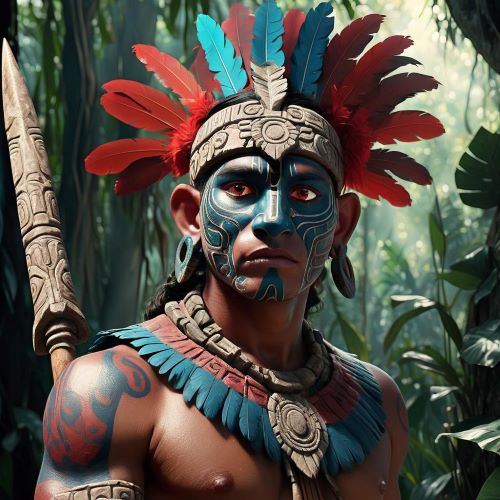Kinich Ahau : The Sun God
Listen
At a glance
| Description | |
|---|---|
| Origin | Mayan Mythology |
| Classification | Gods |
| Family Members | N/A |
| Region | Mexico, Guatemala, Belize, Honduras, and El Salvador |
| Associated With | Sun |
Kinich Ahau
Introduction
Kinich Ahau, the Mayan Sun God, is a central figure in Mayan mythology, revered for his association with the sun. His significance was deeply ingrained in the spiritual and daily practices of the ancient Maya, with his influence enduring from the Classic Period of Maya civilization through to the 20th-century beliefs of the Southern Lacandons. Often depicted as a radiant young man, Kinich Ahau symbolizes light, warmth, and life, making him one of the most important gods in the Mayan pantheon. His name, translating to “Sun Lord” or “Sun King,” reflects his exalted status and vital role in sustaining life, growth, and nourishment. As the bringer of light and knowledge, he also holds associations with music and cultural practices. Kinich Ahau’s legacy persists in modern interpretations of Mayan heritage, where his identity continues to be celebrated in rituals, art, and cultural expressions.
Physical Traits
Kinich Ahau is often portrayed as a youthful man with a golden or greenish complexion, symbolizing his solar essence. His depiction typically includes elaborate feathered headdresses that emphasize his celestial nature. His eyes, sometimes shown as fiery orbs or with a sun motif (k’in infix), represent the sun’s intense light and heat. In some images, he is adorned with a jaguar skin, linking him to the earth and underworld. His facial features, such as an aquiline nose and large, square eyes, are distinctive, and he is often depicted with a filed incisor, a common trait in representations of the sun god. Additionally, Kinich Ahau’s versatility is highlighted in portrayals where he appears as an aquatic bird or a young man paddling a canoe, underscoring his connection to various elements. These artistic representations, rich in symbolism, not only elevate his divine status but also reflect his integral role in the cosmic order.
Family
Kinich Ahau’s role in Mayan mythology is enriched by his connections to other deities, highlighting his importance within the pantheon. He is often depicted as the son of Itzamná, the creator god, and Ixchel, the goddess of the moon, establishing a cosmic balance between the sun and the moon. His relationship with Ixchel, a powerful goddess associated with fertility and childbirth, further intertwines him with key aspects of creation and life. Kinich Ahau is also considered an aspect of Itzamná, underscoring his significance within Mayan religious beliefs. These familial ties and associations with other deities emphasize his vital role in the mythology, linking him to the fundamental forces that shape the Mayan worldview.
Other names
Kinich Ahau is recognized by a range of names across different Maya regions, each highlighting various aspects of his divine nature. In the Yucatán Peninsula, he is also known as Kukulcán, the feathered serpent associated with the spring equinox and world creation. Other regional names include Gukumatz and Tohil, reflecting the local variations in his worship and cultural significance. The name “Kinich Ahau” translates to “Sun-Faced Lord” or “Lord of the Sun’s Eye,” underlining his role as the sun god. During the Classic Period, he was referred to as God G in codices. Additionally, he should be distinguished from Ah K’in or Ah K’in Chob, who are separate deities related to the sun and the calendar.
Powers and Abilities
Kinich Ahau wields considerable powers that underscore his role as the sun god in Mayan culture. He governs the cycle of day and night, influencing time and the seasons, which are vital for agriculture and daily life. His control over light and heat is crucial for sustaining life, providing energy and warmth to the natural world. Kinich Ahau is also linked with divine kingship; Mayan rulers were often seen as his descendants, their authority stemming from their connection to this celestial deity. Additionally, Kinich Ahau is associated with wisdom and enlightenment, embodying the illumination brought by sunlight. His influence extends to the realm of music and ritual, where he is connected with the harmonious rhythms of life, community rituals, and ceremonies. Moreover, Kinich Ahau is thought to possess healing abilities, able to cure diseases and alleviate drought conditions. In some stories, he is portrayed with the power to end the world, highlighting the dual nature of his influence as both nurturing and potentially destructive.
Modern Day Influence
Kinich Ahau’s influence is evident in modern interpretations of Mayan culture and spirituality. He continues to be celebrated in cultural festivals and events that honor ancestral heritage, reflecting the deep connection between humanity and nature. His imagery frequently appears in contemporary artistic expressions, such as murals, dances, and theatrical performances, allowing new generations to engage with their historical roots.
Academic studies on Mayan mythology highlight Kinich Ahau’s role in solar worship and its societal implications, positioning him as an archetype for discussions on resilience, strength, and life’s cyclical nature. This relevance extends into popular culture, where Kinich Ahau inspires depictions in media that explore themes of mythology, spirituality, and identity.
In modern Mayan communities, Kinich Ahau remains integral to religious ceremonies and agricultural practices, symbolizing the essential role of the sun in crop growth. His continued reverence by groups like the Southern Lacandons into the 20th century underscores his enduring significance. Today, his imagery and symbolism also permeate popular culture, illustrating his lasting impact on contemporary views of nature and spirituality.
Related Images
Frequently Asked Questions
What is lorem Ipsum?
I am text block. Click edit button to change this text. Lorem ipsum dolor sit amet, consectetur adipiscing elit. Ut elit tellus, luctus nec ullamcorper mattis, pulvinar dapibus leo.
What is lorem Ipsum?
I am text block. Click edit button to change this text. Lorem ipsum dolor sit amet, consectetur adipiscing elit. Ut elit tellus, luctus nec ullamcorper mattis, pulvinar dapibus leo.
What is lorem Ipsum?
I am text block. Click edit button to change this text. Lorem ipsum dolor sit amet, consectetur adipiscing elit. Ut elit tellus, luctus nec ullamcorper mattis, pulvinar dapibus leo.
What is lorem Ipsum?
I am text block. Click edit button to change this text. Lorem ipsum dolor sit amet, consectetur adipiscing elit. Ut elit tellus, luctus nec ullamcorper mattis, pulvinar dapibus leo.
What is lorem Ipsum?
I am text block. Click edit button to change this text. Lorem ipsum dolor sit amet, consectetur adipiscing elit. Ut elit tellus, luctus nec ullamcorper mattis, pulvinar dapibus leo.

